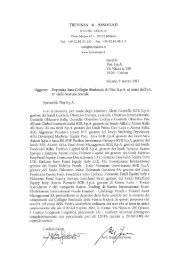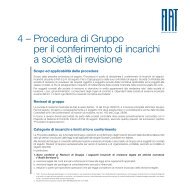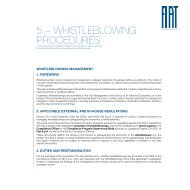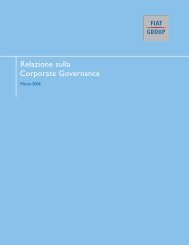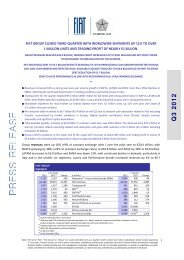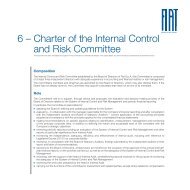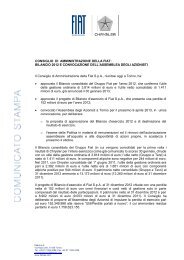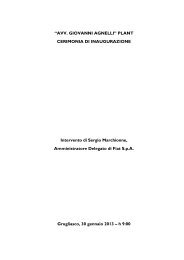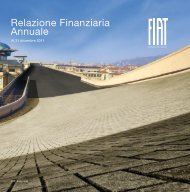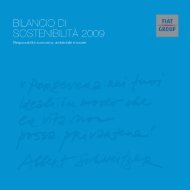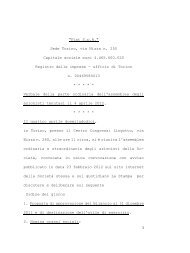2 | Rapporto di sostenibilita? ING:Layout 1 - Fiat SpA
2 | Rapporto di sostenibilita? ING:Layout 1 - Fiat SpA
2 | Rapporto di sostenibilita? ING:Layout 1 - Fiat SpA
Create successful ePaper yourself
Turn your PDF publications into a flip-book with our unique Google optimized e-Paper software.
Raw materials<br />
EN1 (core) Material used by weight or volume.<br />
Annually, <strong>Fiat</strong> Group purchases are valued 33 billion euros,<br />
85% of which for <strong>di</strong>rect materials and the remainder for in<strong>di</strong>rect<br />
materials, services, plants and machinery. 86% of <strong>di</strong>rect<br />
material procurement is carried out through purchasing<br />
organisations present in Europe and North America, and the<br />
remainder in Latin America. Purchases of <strong>di</strong>rect materials are<br />
as follows: 51% metals, 26% electrical and 23% chemicals.<br />
EN2 (core) Percentage of materials used that are recycled input<br />
materials.<br />
On September 18, 2000, EU Directive 2000/53/EC was adopted<br />
by the European Parliament and the Council of the European<br />
Union in order to prevent waste from vehicles by promoting<br />
the reuse, recycling and other forms of recovery of end-of-life<br />
vehicles (ELV), and to improve the environmental performance<br />
of all economic operators involved in the life cycle of vehicles,<br />
and especially carmakers, <strong>di</strong>smantlers and shredders.<br />
Since then, nearly all European Union member states have<br />
transposed the ELV Directive into their own national law.<br />
Current legislation establishes that the last owner of an<br />
end-of-life vehicle can deliver it to an authorised treatment<br />
facility at no cost, and is applicable starting on January 1, 2007<br />
to all vehicles in circulation. In this connection, European<br />
regulation has made vehicle manufacturers responsible for<br />
organising <strong>di</strong>smantling networks where the last owner of an<br />
end-of-life vehicle can deliver it for treatment at no charge.<br />
The form these networks take may vary from country to<br />
country. Thus, setting up an efficient network with high quality<br />
standards and sufficient geographical coverage is the sine qua<br />
non for dealing effectively with end-of-life vehicles. Both<br />
independently and in cooperation with other operators<br />
involved in recycling, <strong>Fiat</strong> Group Automobiles created networks<br />
of <strong>di</strong>smantlers throughout Europe where all vehicles of its<br />
brands are collected at no cost to the owner. The <strong>Fiat</strong> networks<br />
comply with applicable regulations, and they will be<br />
continuously monitored to guarantee that they provide both<br />
the geographical coverage and the quality standards required<br />
by the law. <strong>Fiat</strong> Group Automobiles has made available to its<br />
customers adequate communication through the Internet,<br />
multi-language call centres, owner’s handbooks, and<br />
signboards identifying authorised treatment facilities.<br />
End-of-life vehicles contain many <strong>di</strong>fferent types of material:<br />
steel, plastics, rubber and a whole list of others. In Italy,<br />
around 1.5 million vehicles are scrapped every year, with<br />
over 1.2 million tons of material that must be <strong>di</strong>sposed of.<br />
These figures clearly highlight the value inherent in these ELVs.<br />
For today’s automakers, then, producing vehicles for truly<br />
sustainable mobility is not just a question of reducing tailpipe<br />
emissions or investing in alternative propulsion systems,<br />
it also means designing vehicles and dealing with them at the<br />
end of their life cycle in a way that ensures maximum recovery<br />
of materials, maximum optimisation of energy, and the<br />
48 Performance in<strong>di</strong>cators Environmental performance in<strong>di</strong>cators<br />
Annual procurement volumes by category<br />
Direct materials 85%<br />
In<strong>di</strong>rect materials, services,<br />
equipment and machinery 15%<br />
Annual procurement volumes of <strong>di</strong>rect materials<br />
broken down by geographic area<br />
Europe and North America 86%<br />
Latin America 14%<br />
Annual procurement volumes of <strong>di</strong>rect materials<br />
broken down by product type<br />
Metals 51%<br />
Electricals 26%<br />
Chemicals 23%



